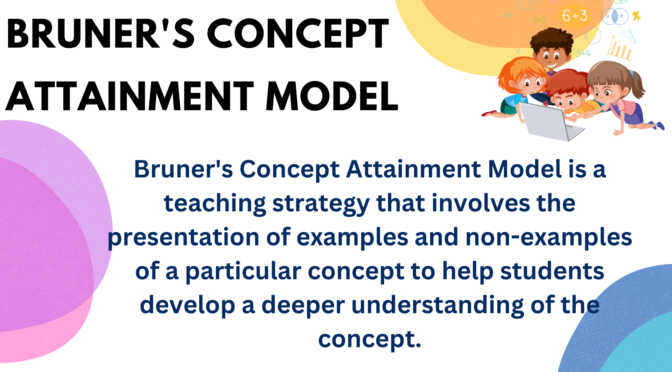Jerome Bruner’s Concept Attainment Model is a teaching strategy that emphasizes the importance of actively engaging students in the process of learning by using a deductive reasoning approach. The model is designed to help students develop critical thinking skills and the ability to make logical connections between ideas.
In the Concept Attainment Model, the teacher presents students with a set of examples, some of which are positive examples (examples of the concept being taught) and some of which are negative examples (examples of what the concept is not). The teacher then asks students to identify the common characteristics of the positive examples and to use deductive reasoning to identify the concept being taught.
About Concept Attainment Model
The students then work together to identify the characteristics that are common to the examples and use this information to generate a hypothesis about the concept being taught. This hypothesis is then tested by applying it to new examples and determining whether the examples fit the concept.
The Concept Attainment Model emphasizes the importance of active participation, critical thinking, and problem-solving skills in the learning process. It is often used to teach complex concepts in a variety of subject areas, including science, mathematics, and social studies. This model is effective in helping students develop a deeper understanding of the material they are learning and apply their knowledge.
Also Read : Mastery Learning Model
Features of Concept Attainment Model
The Concept Attainment Model involves several key steps:
- Identifying the concept: The teacher identifies the concept to be taught and selects a set of positive and negative examples to present to students.
- Presenting the examples: The teacher presents the examples to students, without initially telling them which examples are positive and which are negative.
- Identifying common characteristics: Students work in small groups or individually to identify the common characteristics of the positive examples and to eliminate the negative examples.
- Hypothesizing the concept: Students use deductive reasoning to hypothesize the concept being taught.
- Testing the hypothesis: Students test their hypothesis by applying it to new examples and evaluating whether the examples fit the concept being taught.



Elite Private proxy retailer DreamProxies.com – the best private proxies you will discover with regard to lowest costs!
Holgura mecanica
Dispositivos de calibración: clave para el rendimiento fluido y productivo de las equipos.
En el entorno de la avances moderna, donde la eficiencia y la fiabilidad del equipo son de gran trascendencia, los aparatos de ajuste juegan un tarea vital. Estos equipos específicos están concebidos para calibrar y fijar partes giratorias, ya sea en equipamiento industrial, automóviles de desplazamiento o incluso en dispositivos hogareños.
Para los expertos en conservación de sistemas y los técnicos, utilizar con aparatos de ajuste es importante para promover el operación uniforme y seguro de cualquier aparato dinámico. Gracias a estas herramientas modernas avanzadas, es posible reducir considerablemente las oscilaciones, el ruido y la carga sobre los rodamientos, extendiendo la longevidad de elementos valiosos.
Asimismo significativo es el rol que tienen los dispositivos de ajuste en la asistencia al cliente. El asistencia especializado y el soporte regular usando estos sistemas facilitan brindar servicios de óptima nivel, mejorando la contento de los clientes.
Para los responsables de empresas, la inversión en unidades de equilibrado y medidores puede ser importante para optimizar la rendimiento y rendimiento de sus sistemas. Esto es particularmente relevante para los emprendedores que administran modestas y modestas empresas, donde cada detalle cuenta.
Asimismo, los equipos de balanceo tienen una gran utilización en el ámbito de la protección y el monitoreo de calidad. Permiten detectar probables errores, reduciendo reparaciones onerosas y averías a los aparatos. Incluso, los información generados de estos equipos pueden utilizarse para perfeccionar procedimientos y potenciar la exposición en motores de investigación.
Las áreas de uso de los sistemas de ajuste cubren múltiples industrias, desde la producción de transporte personal hasta el seguimiento del medio ambiente. No interesa si se refiere de extensas elaboraciones de fábrica o reducidos espacios domésticos, los aparatos de equilibrado son esenciales para asegurar un operación eficiente y sin riesgo de fallos.
Vibración de motor
¡Vendemos máquinas para balanceo!
Fabricamos directamente, construyendo en tres ubicaciones al mismo tiempo: Portugal, Argentina y España.
✨Ofrecemos equipos altamente calificados y debido a que somos productores directos, nuestros costos superan en competitividad.
Realizamos envíos a todo el mundo a cualquier país, consulte los detalles técnicos en nuestro sitio web.
El equipo de equilibrio es portátil, de bajo peso, lo que le permite ajustar cualquier elemento giratorio en diversos entornos laborales.